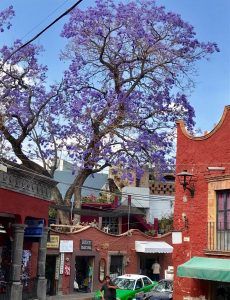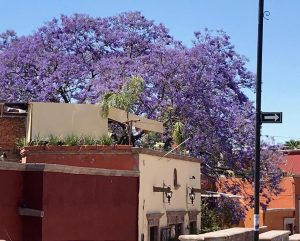Every year at this time, which is to say springtime in San Miguel de Allende in the central mountains of Mexico, when the jacaranda trees are in full bloom, dotting the landscape like purple lollipops, I’m flooded with memories.
I remember the first jacarandas that mesmerized me when I lived in southern Africa in my mid-twenties. I’d never before seen such majestic, purple-robed, spectacularly beautiful trees. These grand árboles lined the broad avenues of what was then known as Salisbury, Rhodesia (now Harare, Zimbabwe), giving it the well deserved label of “City of Flowering Trees.”
Springtime there was known as “jacaranda time” among the British colonials, when these trees came into bloom in October and November each year, springtime in the southern hemisphere. What impressed me most and inspired me then about those jacarandas was the juxtaposition of their soaring strength and their seemingly fragile beauty.
So, decades later, when I lived in the fabled city of Ségou, Mali, in West Africa, doing independent development work, I came up with what I thought was a brilliant idea: to turn Ségou into another “City of Flowering Trees” in Africa.
Knowing that August 4thwas Mali’s annual Journée des Arbes (Day of Trees), in 2000 I proposed that to celebrate this significant day the people of Ségou plant flowering trees all along the main roads.
“In years to come,” I said (in French) to the city’s powers-that-be in an effort to convince them to back my plan, “when the trees are tall and flowering, Ségou will be known as the loveliest city in all of Mali, tourists will be drawn to its beauty, and the economy will prosper as a result.”
My proposal called for one thousand healthy young trees. And I recommended where they could be purchased: from my friend and neighbor, the retired-school-principal-turned-nurseryman Abdoulaye Mariko, the perfect, local pipinieriste, who at the time was struggling to support his ever-growing family.
On the morning of the tree-planting, August 4th, about fifteen neighborhood children arrived at my house at nine and happily marched with me to the main road where the planting had begun, carrying an enormous appliquéd banner I’d made reading “Aimez la Terre: Plantez des Arbes” (Love the Earth, Plant Trees).
When a fresh supply of saplings arrived on Mariko’s charrette (donkey-drawn cart), I threw myself into helping to plant them – digging a hole with a hoe, removing the sapling’s roots from its black plastic bag, placing the tree in the center, dousing the root ball with water before covering it with soil, leaving a well-like surrounding area for rain to pool. As I finished planting each tree, the children circled both the tree and me and applauded.
It was an exciting, exhausting, and exhilarating day. Everyone was pleased. The government officials who’d authorized and partially underwritten the event seemed happy and proud. My friend Mariko was thrilled that he’d earned more in one day than he would normally have earned in four years. All of the volunteer tree planter-participants, including me, were sore but more than satisfied with our efforts.
What none of us had considered, though, were the goats. Sweet, baby trees must be particularly appealing to hungry goats. Sadly, the city’s ubiquitous, free-roaming goats got to these newly planted saplings before any effective goat-barriers could be erected. Within days, all of the trees were decimated, eaten by goats. This well intentioned plan became just another development dream that ultimately died. The forces of nature in Africa, I found, have a way of overriding human plans.
Here in San Miguel now, whenever I stop to admire the towering jacaranda trees in full bloom, I think: Who planted these trees? And how long ago was that? How did they manage to protect them from the goats? Surely there were lots of hungry, roaming goats in the streets back then?
I thank God for those planters’ efforts and their foresight. And I’m unspeakably grateful for this annual gift of springtime splendor in this city.
Here are just a handful of jacaranda photos from my walks in my neighborhood this week:
~ ~ ~ ~ ~ ~ ~
For more on jacarandas, go to www.blog.bonnieleeblack.com/jacaranda-time/.
And for the full story of my work and life in Ségou, Mali, please read my memoir How to Make An African Quilt (Nighthawk Press, 2013), available at www.nighthawk press.com as well as www.amazon.com .







A real source of joy, these trees.
They certainly are, Helaine! Too bad they don’t grow everywhere in the world.
They are the most beautiful trees. We shall have them blossoming in our neighborhood soon, as spring moves north from Mexico to Socal. Sorry about the goats. Thanks for the fantastic photos.
Thanks, Ted! Be sure to take photos of your neighborhood jacarandas when they bloom and post them on FB. I can’t wait to see them! Good to hear from you. Hope all is well, BB
Thank you, BonnieDear, for filling my inbox with jeweled branches!
You’re so welcome, BeDear!
Belleza, la Bonnie! Such beautiful flowers. I remember the story about flirtatious Mariko and the trees, but had forgotten the sad part about the hungry goats.
You have a wonderful memory, querida Te! Yes, I’d almost forgotten about the goats too. I hope you and Gary are doing well. Abrazos fuertes, BB xx
Those Jacaranda trees must make for a beautiful spring. In southern Alberta near the mountains it’s the deer that kill anything that we plant. Here in our yard it took a Mayday Tree more than 20 years to get past a little bush. I finally arborized it and put a page wire fence around it and then it could be the tree it was meant to be.
I applaud your attempt at growing trees.
Thanks so much for sharing your tree story, Carol. Yes, if it’s not goats, it’s deer! It’s a “dog-eat-dog” world out there in Nature. 🙂
Dear Bon,
What beautiful trees. I was just thinking this past week that soon all the trees here in Boston will burst into bloom. Because a year ago I never left my house to see spring happen, I realized I was particularly looking forward to it this year,
I had forgotten the goat story. It does have the makings of a good fable, though, doesn’t it? It also reminds me of the minister in The Poisonwood Bible whose garden is defeated by Africa.
Your vision is inspired. What is more magnificent than rows of towering trees?
Love,
Paul
Ah, I’d forgotten that story in The Poisonwood Bible! Thank you for reminding me, dear Paul. I hope the trees all around you in Boston are twice as beautiful as ever for you this spring, to make up for last year… — xx
Alleluia! The hungry goats must have thanked you all. I’m so thankful the planting efforts were more successful in our beautiful second home in San Miguel!!
Yes, Suzanne, I agree (about the thankful goats)! And thank you for getting the whole point of this story (about the success of the jacaranda plantings here in SMA)! 🙂
Oh, what a wonderful story about the goats, as I have been to Segou many years ago as well! I came home loaded with beautiful clay pots that I still make peanut chicken in and can still smell ‘Africa’ in them. But most of all miss, miss, miss, the blooming Jacarandas of SMA! And miss you mucho.
Love Sally and Art
Yes, I forgot that we have Segou in common, Sally dear. It’s an unforgettable place, isn’t it. So sorry you’re having to miss the jacarandas in SMA this year. Maybe next year!
Thanks, dear Bonnie. You described the joy of seeing these trees live so well. The vision is so uplifting. Loved your efforts in your other planting in yesteryear, and the similar frustrations so many of us have felt in planting and forgetting the wild animals that love them, too – for fodder! Worth the attempt and the communal effort. Keep your blog coming – it is full of inspiration and past stories. Love Marilyn
Thank you, dear Marilyn, for your understanding. Yes, so worth “the communal effort” — goats or no goats! 🙂